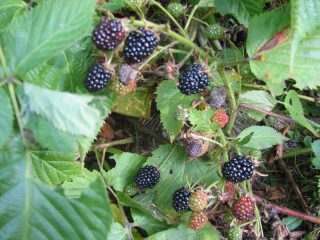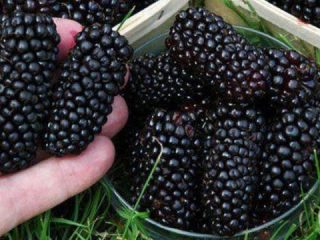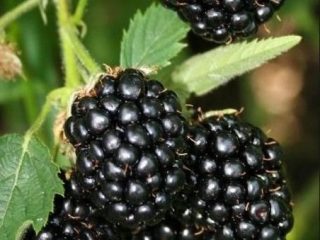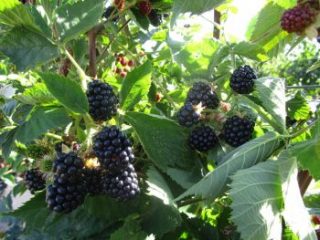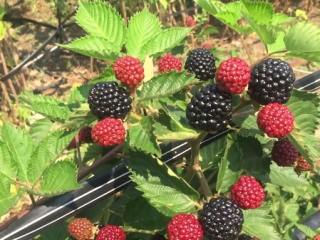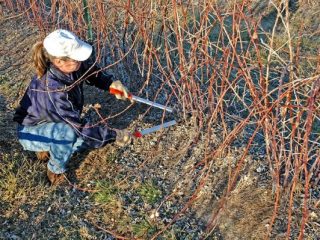Content
Blackberry Rubus Gaj is a promising crop variety that was developed relatively recently. It has many advantages and benefits, but judging by the reviews of gardeners, it requires the fulfillment of certain conditions during cultivation. Before you start growing a crop, you should familiarize yourself with all the rules and nuances, and also try to comply with them during planting and subsequent care.
Origin story
The blackberry variety Gai appeared 14 years ago thanks to the work of the Polish breeder Jan Dainek. The result was obtained during thirty years of work carried out at an experimental station in the city of Brzezina at the Institute of Floriculture and Fruit Growing. Despite the fact that the variety appeared on the market in 2006, its mass sales began in 2008.
The variety is used indoors and outdoors, where due to its poor resistance to ultraviolet radiation in field conditions, it showed the best results. Suitable for fresh use, growing for commercial purposes, suitable for processing.
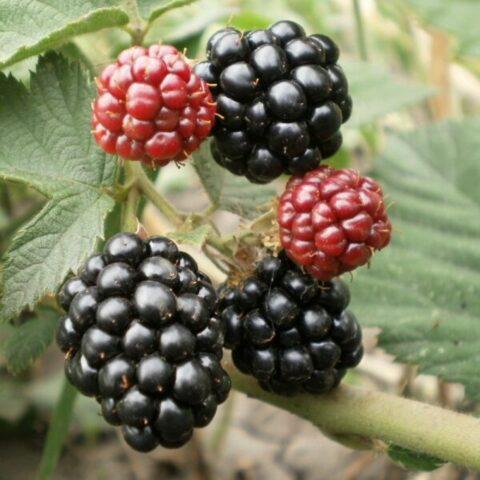
The high-yielding blackberry variety Gai has a medium-early ripening period
Description of the bush and blackberries of the Gai variety
This type of culture has a number of advantages. Gaya bushes are not thorny, the berries have a sweet and delicate taste, are large in size, rich in vitamin and mineral composition and tolerate winter well.
The plant is an upright subshrub (belongs to the bramble) with branched, thornless, rigid shoots that can grow up to 350 cm in height. Laterals have several orders. The foliage of powerful bushes is average, the leaves are dark green in color. The variety is propagated by cuttings and produces virtually no root shoots. The berries are oval-shaped, glossy black in color, the average weight of one fruit is 6-7 g, the maximum is 16 g. Gai blackberries taste sweet, similar to mulberries, almost without acid. Contains a large number of useful elements, especially iron and magnesium. It has a regenerative and choleretic effect, helps cleanse the body of toxins. The density of the fruit is moderately hard, the berry is suitable for transportation.
Characteristics of blackberry Guy
The berries of this variety can be consumed fresh, frozen or dried. Blackberries Gai are suitable for making jam, jam and compote. Excellent as a filling for baked goods. The variety is characterized by good yield; if the plant is provided with favorable growing conditions and proper care, then about 17 kg of ripe berries can be harvested from one adult bush. Most of them are found in the middle and bottom of the bush; in the upper part of the ovary there are almost no ovaries.Due to the elasticity of the berries, the variety tolerates transportation well. The branches are dense and massive, which is why they require garters to stakes or trellises.
Ripening time and yield
Blackberry Guy has a medium-early ripening period. Flowering begins in May, the berries ripen depending on the growing region, usually from mid-summer to the end of September. In northern latitudes, the fruiting period occurs in August; when grown in the middle zone, the harvest begins at the end of July, in the Urals in autumn. The berry quickly acquires a sweet taste and is ready for picking when its color turns black. They are removed as they ripen. They keep well in the refrigerator for up to three weeks.
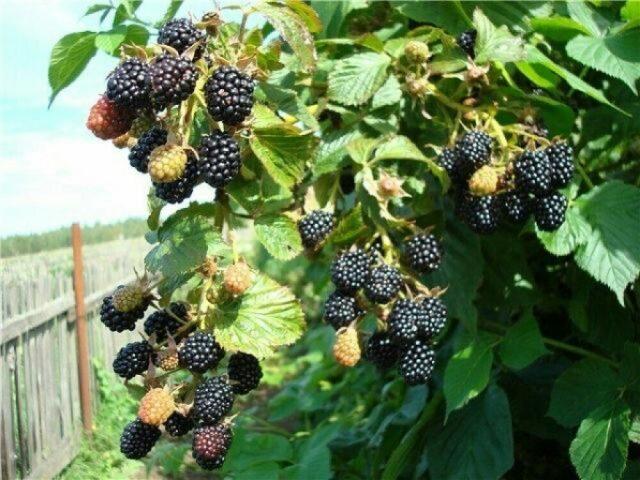
In the fifth year of life, the bush of the Gai variety is capable of producing up to 20 kg of harvest
Frost resistance
Blackberries Gai have average resistance to drought and very high winter hardiness, according to the originator of the variety, up to -30 degrees. But judging by numerous reviews from gardeners, with the arrival of frost it will not be a bad idea to cover the plant, for which it is better to use agrofibre.
Resistance to diseases and pests
The plant's resistance to pests and diseases is moderate; in climatic conditions similar to Poland, and when grown in open ground, it is above average. Problems usually arise due to high humidity, unfavorable conditions or improper care.
Among the diseases, bushes can be exposed to:
- anthracnose;
- rust;
- septoria;
- powdery mildew;
- gray rot;
- purple and white spotting.
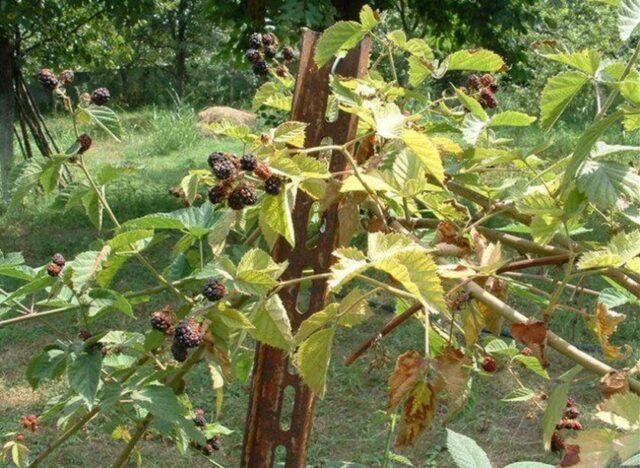
To get rid of diseases, it is recommended to spray the plant with Bordeaux mixture
Insects that can attack Guy blackberries include:
- aphid;
- glassware;
- weevil;
- spider mite;
- moth;
- nutcracker;
- bud moth;
- gall midge

Agronomists recommend using Actellik for parasites.
Pros and cons of Blackberry Guy
Like any plant, in nature the blackberry Guy has its advantages and disadvantages. When growing crops, you may encounter some difficulties.
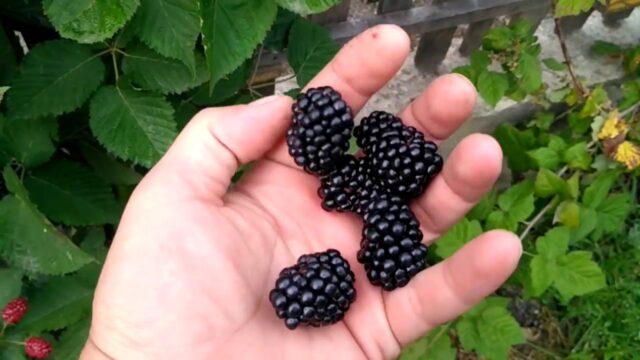
During frequent rainfall, the variety is quickly susceptible to disease.
Advantages of culture:
- high frost resistance;
- good yield;
- suitability for transportation;
- keeping quality;
- taste qualities.
Flaws:
- poor resistance to drought;
- average resistance to diseases;
- need for support;
- Ripening only in warm weather.
How to plant blackberries Guy
The peculiarities of growing Gai blackberries lie in choosing the right place for the seedlings, as well as in following the planting algorithm. It is advisable to perform the procedure in the spring, from the end of April to the second week of May. Since Gaya has average drought tolerance, brightly lit places are not suitable for it. It is better to select an area for the culture in a slightly shaded corner of the garden. As for the soil, blackberries are undemanding to it, but they feel better and produce a better harvest in well-drained loams, where the pH is 6. It is worth noting that the quality of planting material also influences the development of culture. It is better to give preference to annual seedlings with developed rhizomes and formed root buds. There should be two shoots, 4-5 mm thick.
During planting, seedlings should be placed in holes dug at intervals of 1-1.5 m; the distance between rows should be at least 250 cm.It is advisable to pour potassium supplements, manure and superphosphates into the holes before the procedure.
Blackberry care Guy
Without proper regular care, it is unlikely that you will be able to obtain a stable harvest of berries. Guy blackberry bushes require mandatory watering, fertilizing, weeding and pruning. For one and a half months after planting, the plant is watered daily, when the cuttings take root, the frequency of moistening is reduced. After the procedure, weeds are removed.
To retain moisture in the soil longer, it is advisable to mulch the crop circle, for which sawdust, straw and leaves are suitable.
Fertilizers are applied three times a year:
- At the initial stage of the growing season - 20 g of urea per square meter of land.
- At the moment of berry formation - 60 g of potassium sulfate per 10 liters of water.
- After fruiting - potassium fertilizers.
As for pruning, it is carried out every year in the spring before the sap begins to flow. At the age of one year, branches are shortened to 200 cm; broken, diseased, frozen, and fruit-bearing stems are completely removed.
With the arrival of autumn, the trunk circle of the Gai blackberry is covered with straw or organic matter. If the winter in the growing region is harsh, then the bushes are insulated with spunbond.
In the case when the crop grows in the southern regions with mild winters, pinching is an additional step in caring for it. After shortening the growing point, the side branches of the blackberry begin to stretch upward, which prevents them from being laid before winter. Therefore, it is rational to do a second, less harsh pinching for the next branching order.
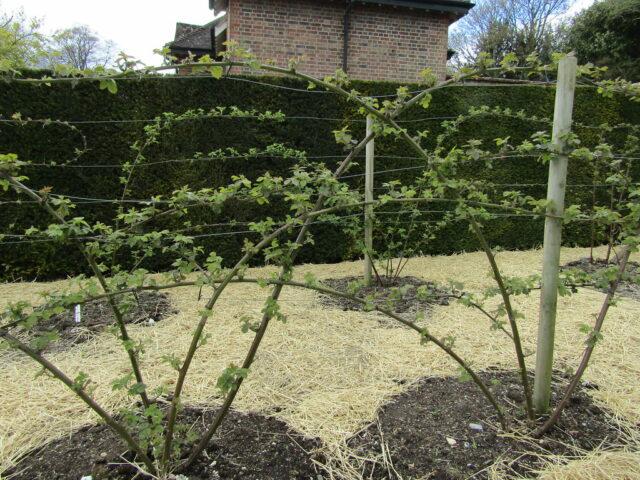
Guy's blackberry lashes are tied to supports as they grow
Reproduction methods
Blackberries of the Gai variety produce few root shoots, which is why it is usually propagated by cuttings. Most often, planting material is cut after the end of the fruiting stage, in the fall, from lignified stems a year or more old. Cuttings 400 cm long are cut, after which they are buried 20 cm deep. When the snow melts, the seedlings are dug up and planted in a permanent place. To ensure rapid rooting, plantings are watered regularly.
Some gardeners propagate this variety by dividing the roots using root segments.
Conclusion
Blackberry Guy is a noteworthy variety of berry, which is considered very unpretentious and undemanding to care. When properly grown, the plant gives a good harvest, the fruits are very sweet and tasty. Reviews about the variety are contradictory; not all summer residents praise the Gai blackberry. Some people fail to achieve success in breeding it.
Reviews from gardeners about blackberries Gai

